Paddy cultivation in India is a common agricultural practices especially in the Gangetic plains. Traditionally, paddy crop is cultivated in flooded fields in India which is both water and labour intensive but it can be cultivated in different methods with different levels of water and labour requirement.
Paddy is widely cultivated in India and other parts of Asia such as China, Japan, Indonesia, Bangladesh, Thailand and other Southeast Asian countries. Globally, China is the leading producer of rice with India being the next.
Paddy Crop at a Glance
Paddy, also known as rice is a major food crop in India. Rice is the staple food of people from southern and eastern parts of India. Paddy plant has a fibrous root with the plant growing up to 6 feet tall. It has a round jointed stem with leaves being long and pointed. The edible seeds which are sold commercially as ‘rice’ grow on the top in the form of separate stalks.
| Scientific Name | Oryza sativa |
| Common Name | Paddy/Rice (English), Dhaan/Chawal (Hindi), Dhaan/Chaal (Bengali), Nel (Tamil), Vari (Telugu), Nellu (Malayalam) |
| Planting Season | All season |
| Crop Duration | 90-180 days including nursery |
| Crop Type | Food crops |
Uses of Paddy
Paddy has multitude of uses globally. The grain ‘rice’ is a staple food in countries like India, China, Japan and Southeast Asia. Rice flour is used in various food preparations. An alcoholic beverage is made from rice and is popular among Indian rural consumers. Broken rice and rice husks are used as animal feeds and have other industrial uses. Rice oil is produced from the rice bran during the rice polishing stage. The by-product paddy straw is used as animal feed, low cost roofing material, mat, mushroom cultivation, poultry litter etc. Paddy straw and rice husk is processed and is increasingly used in innovative environment friendly products like paper, packaging materials, single-use cups, plates etc.
Popular Paddy Varieties
There are over 40,000 varieties of rice globally among which only 333 varieties are notified in India. These varieties are categorized into short, medium and long duration according to crop duration. But characteristically rice is divided into basmati (aromatic) and non-basmati rice. Sona Masuri, Jeera rice, Ambemohar, Kolam and world famous aromatic long grain ‘Basmati rice’ are few popular rice varieties in India. Tulaipanji, Gobindobhog, Kanakchur etc. are popular aromatic rice varieties in West Bengal.
In recent times, health conscious consumers are looking for unpolished ‘brown rice’ and ‘black rice’ instead of regular polished ‘white rice’ for their daily consumption.
Ideal Conditions for Paddy Cultivation
Growing rice is a laborious and water intensive job. Therefore, rice is traditionally cultivated in those places wherein cheap labour and high rainfall is available. In recent times with increased mechanization and improved farm practices rice can be grown in India with low labour and water cost.
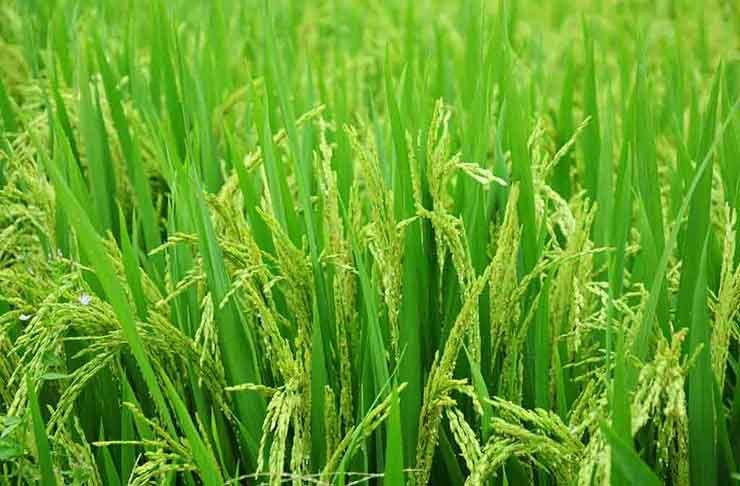
Climate
Paddy is a tropical crop that can grow from sea level to an altitude of 3000 meters. Paddy can also be grown in temperate and sub-tropical climate under humid conditions. High temperature, humid air and high rainfall are the primary requirements of rice production. Temperature ranging between 20⁰C and 40⁰C are ideal.
Season for Growing Paddy
Since rice can grow in a variety of climate and altitude there are different paddy growing seasons in different parts of the country. In areas of high rainfall and low winter temperature (northern and western parts) paddy is grown once a year- during May to November. Two or three crops are grown in the southern and eastern states. India has three rice farming seasons- summer, autumn and winter. However, the chief rice growing season is ‘kharif’ season also called ‘winter rice’. The sowing time is June-July and is harvested during November- December months. 84% of the country’s rice supply is grown in the kharif crop.
Rice cultivated during ‘rabi’ season is also called as ‘summer rice’. It is sown in the months of November to February and harvested during March to June. 9% of total rice crop is grown in this season. Early maturing varieties are normally grown during this time.
The pre-kharif or ‘autumn rice’ is sown during May to August. The sowing time also depends on the rainfall and weather condition. Hence the timing may differ slightly from place to place. Generally, it is harvested during September- October months. 7% of the total rice crop in India grows in this season and short duration varieties which mature within 90-110 days are cultivated.
Paddy Season in West Bengal
| Season | Planting Time | Harvesting Time |
|---|---|---|
| Aus | March-April | June-July |
| Aman | June-July | November-December |
| Boro | December-January | May-June |
Soil
Almost every type of soil can be used for rice cultivation provided the region has a high level of humidity, sufficient rainfall with irrigational facilities and a high temperature. The major types of soils for rice cultivation in India are black soil, red soil (loamy and yellow), laterite soil, red sandy, terai, hill and medium to shallow black soil. The soil can be both acidic as well as alkaline. It can even be cultivated on silts and gravels but paddy grows best in soil with rich organic matter which powders easily on drying or forms a puddle when wet.
Water
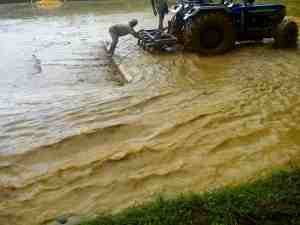
To produce a kilogram of rice the crop on an average needs about 1500 liters of water. In other words, rice needs a huge amount of water for cultivation. In this wet cultivation method paddy fields are flooded continuously up to 7-10 days before harvesting. This continuous flooding practice is followed to ensure weed control and sufficient water supply. Flooded soil also ensures:
- Better nutrient availability
- Moisture stress elimination
- Micro-climate for favorable crop production
In the wake of water scarcity threatening the world, efficient practices are being followed to optimize the yield.
Paddy Cultivation Methods
There are four different practices of cultivation of rice, viz. transplantation method, drilling method, broadcast method and Japanese method.
- Transplantation is the most commonly used method wherein seeds are first sown in nursery and the seedlings are transplanted to the main field once they show 3-4 leaves. Although this is the best yielding method, it requires heavy labor.
- Drilling method is exclusive to India. In this method, one person ploughs a hole in the land and the other person sows the seed. Ox is the most commonly used ‘person’ to plough the land.
- Broadcast method generally involves scattering of the seeds manually over a large area or in the entire field. Labor involved is very less and so is the precision. This method produces very less yield as compared to others.
- Japanese method has been adopted for the high yielding variety of rice and those that need a high amount of fertilizers. Seeds are sown in nursery beds and then transplanted to the main field. It has shown tremendous success for the high yielding varieties.
Another newly found technique is SRI method of rice cultivation. This is a high yielding method with less water but this method is more laborious.
Paddy Cultivation Process Step-by-Step
Most farmers practice nursery bed method with bund farming system in India. Listed below are different stages of paddy cultivation process in transplantation method.
1. Selection of Planting Material
Rice is propagated from seeds. Therefore, seed selection plays a critical role in the yield. Some points that must be noted for selecting best quality paddy seeds are:
- Seeds must be fully-developed and mature
- Clean paddy seeds
- No signs of aging
- Higher germination rate
2. Treatment of Seeds
The seeds must be soaked in salt solution for 10 minutes. The ones that float must be discarded while the ones that sink are mature seeds and must be used for planting. Immediately wash the seeds after removing from the solution. Farmers are advised to soak the seeds in a good fungicide solution like carbendazim for 24 hours. This ensures the seed protection from fungal diseases. If the area of cultivation is prevalent in bacterial diseases like leaf blight, then the seeds must be soaked in Streptocycline solution for 12 hours. Seeds are then dried thoroughly under shade and then used for sowing in nursery bed.
3. Preparation of Nursery Bed
Nursery beds are made occupying about 1/20th of the total field area. Paddy seeds are sown in the bed. Young paddy plants are ready within 25 days of sowing in low land areas while in higher altitudes they take about 55 days to become ready for transplantation.
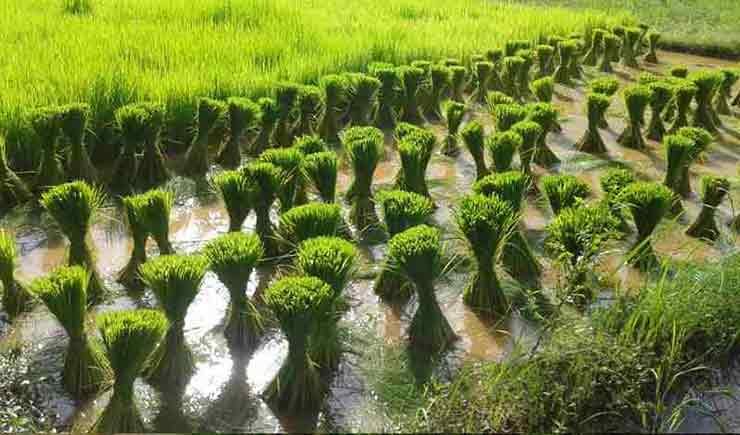
4. Land Preparation for Paddy Farming
Rice is cultivated in different methods depending on the water availability and weather. In areas where the rainfall is abundant clubbed with abundant water supply, wet system of cultivation is followed. On the other hand, in areas where irrigation facilities are unavailable and water is scarce, dry cultivation system is followed. Indian farmers mostly follow wet cultivation.
a. Leveling the Field
Uneven field is consumes nearly 10% extra water than what is necessary for growth. The field is generally plowed twice before leveling. The second plowing is done with water in the field so as to define the high and low areas.
b. Filling the Cracks in Soil
When there are deep cracks present in the soil a huge amount of water can be lost due to drainage of water through these cracks that run below the root zone. In such cases, the cracks must be filled before soaking. One of the ways is to do a shallow tillage before soaking the land. In case of clayey soils the land is puddled since it results in a hard pan. However, for heavily clayey soils puddling is not necessary.
c. Bund Construction
Bunds form a boundary and hence limit water loss. They must be compact and high enough to avoid overflowing of water in case of rains. Rat holes and cracks must be plastered.
d. Field Channels
Separate field channels are constructed to allow water to be delivered to individual seed beds. Thus the main paddy field is not watered till it is time to actually plant in the main field. It is important to control the water flowing to the rice field or draining away from the field. This is necessary so that the nutrients applied are not lost.
5. Transplanting
The land is thoroughly ploughed and flooded with water up to 5cm in depth. In case of clayey or loamy soil the depth must be 10 cm. Post puddling the land is levelled so as to ensure uniform water distribution. Young rice plants are transplanted from nursery bed after leveling. In recent times, young paddy plants are transplanted using cultivation machines (rice transplanters) to save labour cost.
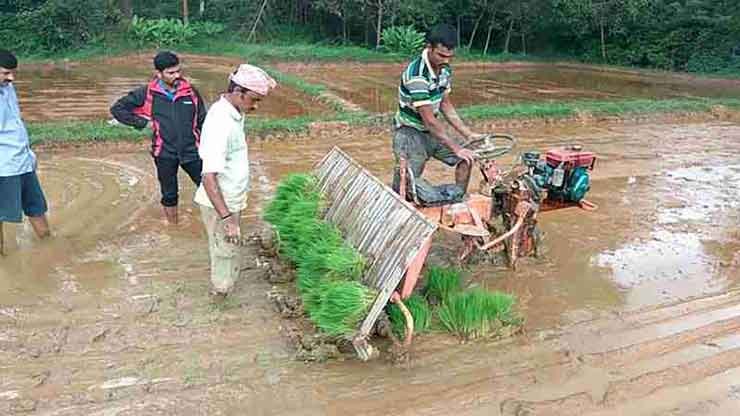
6. Weeding
Flooded rice field prohibits weeds to grow but periodic weeding is required to maintain the field. Manual weeding is effective and sufficient.
7. Harvesting Rice
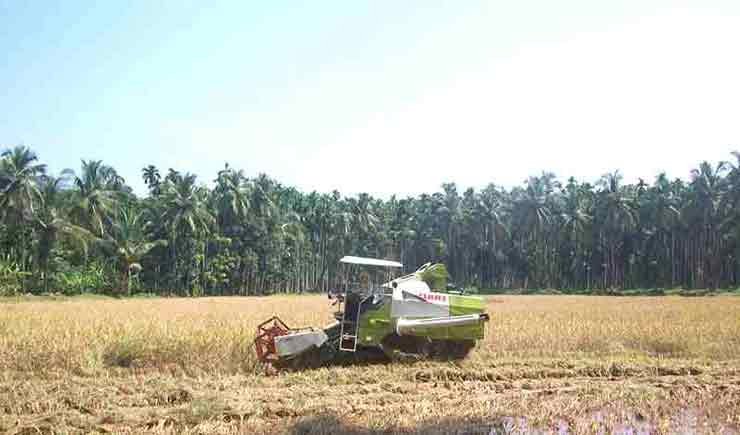
One of the essential factors in rice cultivation is timely harvesting otherwise the grains would drop from the paddy plant. Irrigation of the field is completely stopped about a week before harvesting. This dehydration process helps in grain ripening. It also hastens maturity. In case of early and medium maturing varieties, harvesting should be carried out 25-30 days after flowering. The late maturing varieties are harvested 40 days after flowering. They are generally harvested when the moisture content is about 25%. Post harvesting, drying is carried out gradually under shade.
Paddy Crop Diseases and Control
Paddy suffers from few diseases. Below is a list of major paddy diseases and measures to control them.
| Disease | Symptoms | Management |
|---|---|---|
| Blast |
|
|
| Brown Spot |
|
|
| Bacterial Blight |
|
|
| Udbatta Disease |
|
|
| Sheath Blight |
|
|
Crop Rotation with Rice Crop
Legumes are the most commonly used crops used for crop rotation with rice. This is especially in case of places with lower water supply. Rice in such places is cultivated only once a year and the rest of the year the land is fallow. Hence planting legumes in such period would optimize land use and also help increase fertility of soil.
Yield
Average paddy yield per acre is about 22-25 quintal in a single season. The yield varies between 10 to 40 quintal per acre depending on soil, water availability, variety and farm practices. Considering total paddy production in a year (3 seasons), it can be said that paddy farming is fairly profitable.
Rice Cultivation Precautions
Seed selection is one of the most important factor in rice/paddy cultivation. Seeds must be fully grown and mature without any sign of aging. Seeds with high capacity germination will ensure maximum return on investment. Seeds must be soaked to salt water for 10 minutes, seeds which floats must be discarded. Then the seeds must be washed immediately and treated with fungicides and streptocycline solution to get disease free paddy tree.
Conclusion
Paddy falls under low-risk low-return category. Government provide MSP (Minimum Support Price) to control price and supply of paddy. Government is procuring paddy in 2023-24 with an MSP of Rs. 2183/quintal for common grade and Rs. 2203/quintal for ‘A’ grade paddy.
If done scientifically with mechanized labour including planting, harvesting and thrashing cultivation of paddy can provide a medium to low but secure income source in India.
Some Frequently Asked Questions
West Bengal is the largest rice producing state in India followed by Uttar Pradesh, Odisha, Tamil Nadu, Andhra Pradesh, Telangana, Punjab, Bihar, Chhattisgarh, Assam and Haryana. Total area under rice production in 2022-23 is estimated around 47,000,000 hectare.
People often confuse about the difference between paddy and rice. The complete fruit with the outer skin(shell/husk) still on the grain is called paddy as the seeds are covered with a brown colored husk. The paddy is then harvested and dehusked resulting in the commercially important rice. Technically, paddy vs rice is only the difference of the outer husk.
The cost of cultivation of paddy per acre comes around Rs. 22,000-25,000 per acre in West Bengal. Considering an average yield of 25 quintal/acre and an MSP of Rs. 2183/quintal one may profit Rs. (54,575-25,000) = Rs. 29,575 per acre.
Azolla is a great biofertilizer for paddy cultivation. This is a fern and easily grows on flooded paddy fields.
Want some more like management, chemicals name of pesticide and want to know about clearly the methods of showing or plating and want state wide cultivation details also and want to know resistant variety names also, thanks.
I am 65years old 40 years out sides India for jobs.
Nowadays I am really wants to Paddy’s cultivation how to do and good product.
Please advise me.
I am from West Bengal, India. I Want to know more like management, chemicals name of pesticide for different types of disease and about clearly the methods of showing or planting and also about production cost . Thanks.
I am from West Bengal, India. I want to make more money from paddy cultivation. What should I do . Plz help
I have one acre of land where I want to develop a good yielding variety Rice with organic fertilizer. Kindly suggest. Dr Ibohal singh ENT SpecialistDrTh. Ibohal
if we adopt DSR or SSR method then we can save 50% water. less than other method. These are very useful methods for dry lands. and right now in India continuously shortage of ground water
what type of fertilizer can be used. Please explain with period from sowing and what amount used for various types of fertilizer.
Hi, good afternoon,
I’am from Papua New Guinea.
Id like to get some advice and technical assistant from you on the cultivation practices and methods of how to go about to cultivate lowland rice(wetland) from nursery, field and land preparation,constructing of paddy, water input, fertilizer application, insect & pest application, ideas of bird netting and etc.
Thank you.
disease and pest Symptoms, And their control solution giving on details.
dear sir,
I want paddy crop cultivation method sowing to storage , please send me in my email. as soon as possible sir.